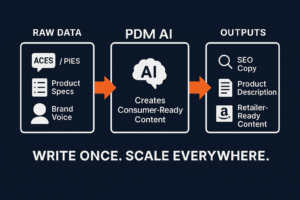In the highly competitive automotive aftermarket industry, the key to success for suppliers and retailers lies in adopting content-centric strategies. These strategies focus on accurately connecting buyers with the right products. When automotive enthusiasts, shade tree mechanics, or professional shops search for parts online, they expect to find exactly what they need for their specific vehicle make and model. This seamless buyer experience hinges on effective and scalable product content management. Otherwise, inaccurate content exchange between suppliers and e-commerce platforms often results in incorrect purchases, leading to returns and poor customer experience.
The foundation of product content: standardized data formats
To manage the extensive catalog of millions of parts for thousands of vehicles, suppliers and retailers utilize two standardized data formats known as ACES (Aftermarket Catalog Exchange Standard); the fitment data such as year, make, and model, and Product Information Exchange Standard (PIES); the product data such as images, specs, and weight, to ensure that specific parts fit specific vehicles.
ACES and PIES data translate the product data between suppliers and e-commerce sites such as Amazon, Walmart, eBay, and Advance Auto Parts so their customers can find the exact part they are looking for.
Three things you can do to maximize your impact with strategic product content management
- Follow data standards: Use ACES and PIES to standardize your product content. ACES and PIES create a comprehensive data picture that aids in efficient product search and comparison. For aftermarket suppliers, managing ACES and PIES data is essential. This data ensures accuracy and efficiency and protects the bottom line by reducing errors and product returns. Solutions such as PDM Automotive standardize product data in ACES and PIES formats, making sharing accurate and complete product content with resellers and marketplaces faster and easier.
- Focus on SEO-friendly product listings: Utilize SEO-friendly product descriptions, incorporating relevant keywords, to enhance visibility in search results. This not only increases organic traffic but also increases product visibility across digital sales channels. PDM’s platform harnesses AI to streamline content creation and deploy it across every digital sales channel. PDM’s AI technology automatically crafts SEO titles, descriptions, and marketing copy based on keywords and inputs. The feature reduces manual efforts and errors in managing extensive product inventories and improves search, making it easier for customers to find the correct products.
- Prioritize high-quality images: High-quality images are essential to product listings to increase conversions and to stand out from competitors. Clear, detailed, and professionally presented images not only improve the overall look and feel of the listing but also provide customers with the necessary information to make a purchasing decision. Zoomed-in photos of distinctive features, before and after photos—especially if the part changes the vehicle’s appearance—and highlighting multiple colors build the buyer’s confidence.
How to streamline product content management: The old way vs. the new way
The old way
Traditionally, suppliers and retailers have grappled with multiple methods of properly uploading fitment data to e-commerce sites. Amazon uses a bespoke Automotive Fitment Manager utility that pulls data from XML files, while other sites rely on load sheets filled with fitment data. Once this data is uploaded, there is a waiting period while the information is loaded into the system, and eventually, the products make it onto the e-commerce site.
This process is manual, inefficient, and error-prone and limits customer reach without a scalable solution to manage product content and distribute it across various sales channels.
The new way
Product Information Management (PIM) platforms, such as PDM Automotive, streamline product content management for automotive aftermarket suppliers and retailers. PDM enables suppliers to quickly update product information, ensuring real-time accuracy across all sales channels. Centralized data also reduces the risk of errors inherent in manual processes and significantly reduces the time to market for new products. Instead of manually updating product listings everywhere you sell your products or constantly sending resellers updated product information, all product content is stored in a single platform for suppliers to manage and for resellers to access and download in any format
Manage product content without manual hassles
Accurate and comprehensive product content management is the foundation of a successful content-centric strategy in the automotive aftermarket industry. Learn how to adopt a content-driven approach to maximize customer satisfaction and grow your business using PDM Automotive. Contact our team today to learn more!
Check out these other resources
The Ultimate Guide to ACES and PIES
How to Upload Fitment Data to Amazon
How to Maximize Amazon Sales with Amazon A+ and A+ Premium Content


